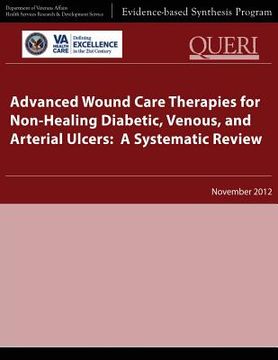Advanced Wound Care Therapies for Non-Healing Diabetic, Venous, and Arterial Ulcers: A Systematic Review
Synopsis "Advanced Wound Care Therapies for Non-Healing Diabetic, Venous, and Arterial Ulcers: A Systematic Review"
Chronic ulcers (i.e., ulcers that are unresponsive to initial therapy or that persist despite appropriate care) are estimated to affect over 6 million people in the United States. The incidence is expected to increase as the population ages and as the number of individuals with diabetes increases. Chronic ulcers negatively affect the quality of life and productivity of the patient and represent a substantial financial burden to the health care system. Lower extremity ulcers, especially those attributed to either diabetes, venous disease, or arterial disease comprise a substantial proportion of chronic ulcers. Approximately 15% to 25% of individuals with diabetes develop a foot ulcer at some point in their lifetime and an estimated 12% of those patients require lower extremity amputation. Healing is complicated by diabetic neuropathy and susceptibility to infection. Venous disease accounts for the majority of chronic lower extremity ulcers. Venous hypertension secondary to various causes results in damage to vessel walls and ultimately leads to skin breakdown. Arterial ulcers are less common and are a result of impaired circulation which can affect healing lead to ulceration. Standard treatment for diabetic ulcers includes debridement of necrotic tissue, infection control, local ulcer care, mechanical off-loading, management of blood glucose levels, and education on foot care. For venous ulcers, standard treatment typically includes the use of mechanical compression and limb elevation to reverse tissue edema and improve venous blood flow. Care for ulcers caused by arterial insufficiency is centered on reestablishing blood flow and minimizing further loss of tissue perfusion. If ulcers do not adequately heal with standard treatment, additional modalities may be required - these are often termed "advanced wound care therapies." Lower extremity ulcers are frequently classified etiologically as diabetic, venous or arterial, though overlap may exist. Treatment modalities and wound care therapies are often selected based on the ulcer characteristics as well as patient factors, past treatment, and provider preference. A large and growing array of advanced wound care therapies of different composition and indications have been developed though their efficacy, comparative effectiveness and harm is not well established. The purpose of this review is to synthesize the evidence on therapies for non-healing diabetic, venous, and arterial lower extremity ulcers and is intended to provide an evidence base to guide clinical practice and policy needs within the VA. We recognize that a non-healing ulcer is likely a result of multiple factors and comorbid conditions. We group studies in the review according to the study authors' description of the included ulcer type. The review focuses on FDA-approved therapies and examines clinically relevant outcomes. We address the following key questions: Key Question #1. What are the efficacy and harms of therapies for diabetic ulcers? Is efficacy dependent on ancillary therapies? Does efficacy differ according to patient demographics, comorbid conditions, treatment compliance, or activity level? Key Question #2. What are the efficacy and harms of therapies for venous ulcers? Is efficacy dependent on ancillary therapies? Does efficacy differ according to patient demographics, comorbid conditions, treatment compliance, or activity level? Key Question #3. What are the efficacy and harms of therapies for arterial ulcers? Is efficacy dependent on ancillary therapies? Does efficacy differ according to patient demographics, comorbid conditions, treatment compliance, or activity level?

